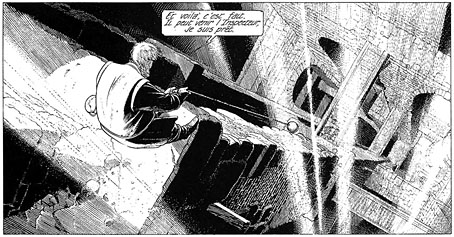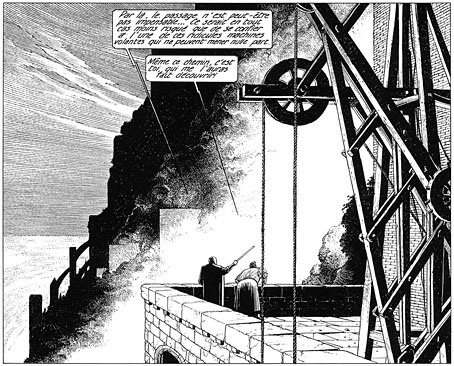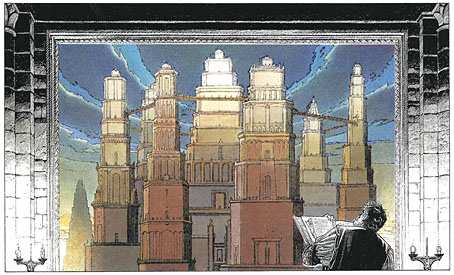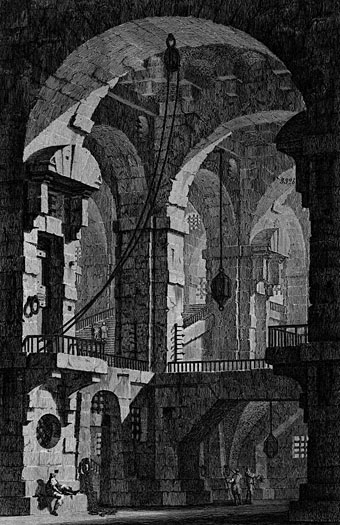
La Tour (1987) by François Schuiten and Benoît Peeters is the third story in the Cités Obscures series, although it’s the fourth volume if you want to be strictly canon about things, L’archivist, a guide to places in the Obscure World, having preceded it.
Carcere Oscura by Piranesi (1750).
This is another book where Schuiten and Peeters’ interests tick a list of my own obsessions, being a tale which seems to originate in the question “What would it be like if you crossed Piranesi‘s Prisons etchings with Bruegel’s Tower of Babel?” The protagonist of La Tour, Giovanni Battista, has his name borrowed from Piranesi’s forenames and his appearance taken from Orson Welles’ Falstaff in Chimes at Midnight. The story owes something to Kafka, although it lacks Kafka’s drift towards paradox, concerning a colossal building referred to throughout as The Tower, a structure we only ever see in close-up—and then mostly from the inside—but whose height must reach several thousand feet.

Battista (above) is one of the Keepers, a group of men charged with maintaining small sections of the Tower whose structure suffers continual decay and collapse. Tired of years spent in complete isolation, and concerned that other Keepers aren’t doing their job, Battista goes in search of the Tower’s feared Inspectors, only to discover that the lack of maintenance is endemic and few of the Tower’s scattered residents have any idea of the origin or purpose of the vast building where they’ve spent their lives, never mind a concern for its upkeep. There are no Inspectors, and while Battista is worried at the beginning about vines in the stonework, we later see small forests growing among the ruins. Kafka resonances come with the mention of the mysterious Base, and the equally mysterious Pioneers, those builders and engineers who went ahead years or even centuries before, climbing skyward.

It’s a surprise reading this book after the first two with their late 19th and early 20th century appearance. The world of La Tour is quite medieval, especially the small community in which Battista finds himself after a near-fatal fall from a jerry-rigged kite. The most sophisticated technology we see is in the home of a doctor, Elias, whose house contains histories of the Tower’s construction as well as astrolabes and armillary spheres. (The latter device plays a key role in a later story.) The only clue we’re in the Obscure World at all comes with a close view of a polyhedral globe which shows the Tower on one face with the cities of Xhystos and Samaris on the others. Aside from Elias, none of the inhabitants of the Tower are aware of, or curious about, anything outside their vast building.

Elias also has a collection of paintings which show the history of the Tower’s design. Several of these are Schuiten’s variations on famous pictures, including the Bruegel Tower of Babel. Less familiar is a version of the curious Historical Monument of the American Republic (1867-88) by Erastus Salisbury Field. The paintings in the Tower are distinguished by being shown in colour while everything else is black-and-white, a distinction used later in the story to striking effect.
Historical Monument of the American Republic by Erastus Salisbury Field (1867–88).
This is a far longer book than the previous ones, and its final third concerns a fascinating journey of several weeks by Battista and a young woman, Milena, up the Tower in search of the Pioneers. Once again, I don’t want to spoil the story but it rather runs out of steam at the end; as with Les Murailles de Samaris there’s a feeling that the creators weren’t sure what to do with their splendid creation once they’d invented it. But the drawing more than makes up for that, with Schuiten once again showing an apparently effortless mastery of a given style, superbly rendering walls of Piranesian vastness, Chartres-like flying buttresses and masses of cross-hatched shading. The journey to the top of the Tower—and the return down—is worth it for the view alone.
• Piranesi / Schuiten. Arquitectura, Comics y Clasicismo | A Spanish examination of Piranesi’s influence on Schuiten.
Elsewhere on { feuilleton }
• The fantastic art archive
Previously on { feuilleton }
• La fièvre d’Urbicande by Schuiten & Peeters
• Les Murailles de Samaris by Schuiten & Peeters
• The art of François Schuiten
• Taxandria, or Raoul Servais meets Paul Delvaux
• Aldous Huxley on Piranesi’s Prisons



This looks incredible, I’ll have to look for it.
This sounds fascinating!
Great review – stirred my imagination! Wow, generations working isolated within this ‘tower’ -horrible but wonderful story. Incredible illustration. Yes, tower is Bruegel-esk. I love armillary spheres- but didn’t know they had a name. Will be hunting this down. Great post. Betty
John, I can’t tell you how many times doing an image search on Google has led me to Feuilleton!!
That happens to me quite often as well, in which case it can be frustrating.